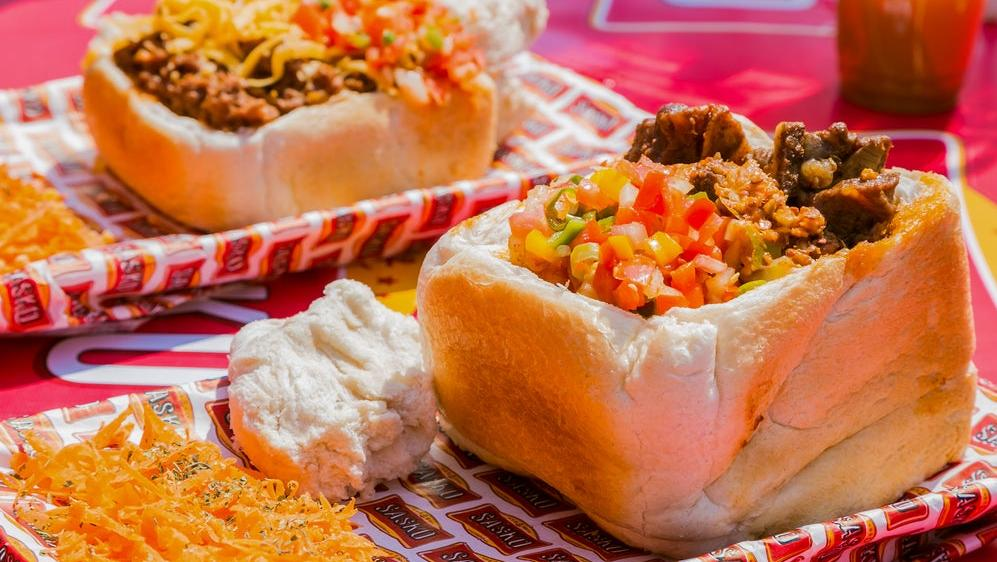Bunny Chow Isn't What It Sounds Like
This curry-and-bread dish is a hearty bite of South Africa’s complex history.
When I prepared for my first trip to South Africa, there were a few "musts" that I knew I had to experience. The list didn't include typical tourist highlights like going on a safari (although I did go on one, and it was phenomenal) or wine tasting in Cape Winelands. Instead, I wanted to get a sense of South African culture and witness a traditional Zulu dance, walk through a township, and sample that essential South African dish: bunny chow.
South African food, beer, and culture
From the time I landed in South Africa, it felt like I was surrounded by music and dancing wherever I went. No matter if I was in a big city like Johannesburg or a rural village, there was always music, art and dance incorporated into the environment, usually all three. In Cape Town, I was astounded to happen upon a full-on choir, singing gospel tunes and dancing in a square on a Saturday night. In Durban, I was thrilled to listen to the soaring a cappella melodies of three Zulu women, crooning and dancing on the beach.
But it was in the village of Isithumba, near a valley of 1,000 hills, that I witnessed the full power of Zulu dance. I watched three boys and girls covered in beading and embroidered cloth dance the ingoma: They took turns taking forceful steps and swinging their legs into high kicks as they chanted in a staccato rhythm. One girl pounded the ground with such ferocity, I felt the reverberations underfoot.
The dance celebrates turning points like coming of age or weddings, and I felt every part of their excitement. Their exuberance prompted one of the dancers to pull me into the dance; I quickly discovered those high kicks were not quite as effortless as they looked. The experience was completed with healthy swigs of umqombothi, traditional beer brewed outdoors with corn and sorghum into a thick liquid that packs a heady punch. It made me forget all about those kicks.
I loved the lakes and gorges of the South African countryside. but when I finally stepped into the bustling Khayelitsha township just outside of Cape Town, I felt a connection to the complexity of South African history. From 1948 until 1994, the brutal institutionalized racial segregation system of apartheid forced non-white citizens to move out of desirable city centers and into isolated areas. Most of the contemporary music, culture, and art forms that I observed, like beat-heavy kwaito music and the barbecued mixed grill of shisa nyama, were developed inside of townships, and I wanted to go to the source of all that creative inspiration.
Shisa nyama and other traditional dishes
Walking through the gravel roads, vibrant murals highlighting community notables and traditional images framed the paths. I stepped into the hand-painted storefront of 4Roomed eKasi Culture & Foods, where award-winning chef Abigail Mbalo served up stylized versions of the dishes she grew up eating in her namesake four-roomed house.
First up was unqua, a dense cornmeal porridge (pap) that Mbalo updated with truffle oil, beetroot, and butternut squash, for a rich and creamy taste. The highlight of the meal was the chef's unique version of shisa nyama, with sous-vide lamb, beef, and smoked chicken. Served with grilled veggies and chakalaka, a spicy mix of tomatoes, carrots, and beans that I fell in love with, the juicy braised meats intensified the freshness and spice of the relish.
It was an altogether great intro to South African cuisine, but I was still waiting for the country's ultimate fast food dish.
What is bunny chow?
I finally got my chance to try bunny chow in its birthplace of Durban. This coastal beach town is famous for the mix of Indian and African cultures that each contributed to this dish. I headed to a seaside restaurant that had been recommended by locals for a "proper bunny."
I don't know what I expected, exactly, but the plate I found in front of me—piled with a hollowed-out loaf of white bread overflowing with curry—was not it.
I had always heard of people grabbing bunny chows after late-night partying, so I had envisioned something at least more portable than this. Ironically, the dish's creation was prompted by convenience. Indian migrant laborers, originally brought in as indentured servants to work the region's sugar plantations, were looking for easy ways to transport curries to work. Encasing them in a vessel of cheap white bread was the answer.
Soon, the portability of bunny chow made it a logical choice for more people. Black South Africans barred from eating at restaurants during apartheid started ordering the dish for take-away, and its popularity steadily spread throughout the rest of the country.
My bunny chow was accompanied by thick chips (fries), a tray of sambal (a grated carrot and onion salad), and achaar, a type of Indian pickle. It didn't look like anything fast or portable, but I dipped the end of the loaf into the curry and the flavors of turmeric and cardamom spiked my tongue. Not spicy, but flavorful and filling; I immediately understood why Bunny chow is so popular. It's a way to eat curries without utensils and the bread sops up the sauce much better than a fork can transport it.
As I nibbled the last of the curry-soaked bread, I was busting with fullness and a newfound appreciation for the diversity of South African cuisine.
